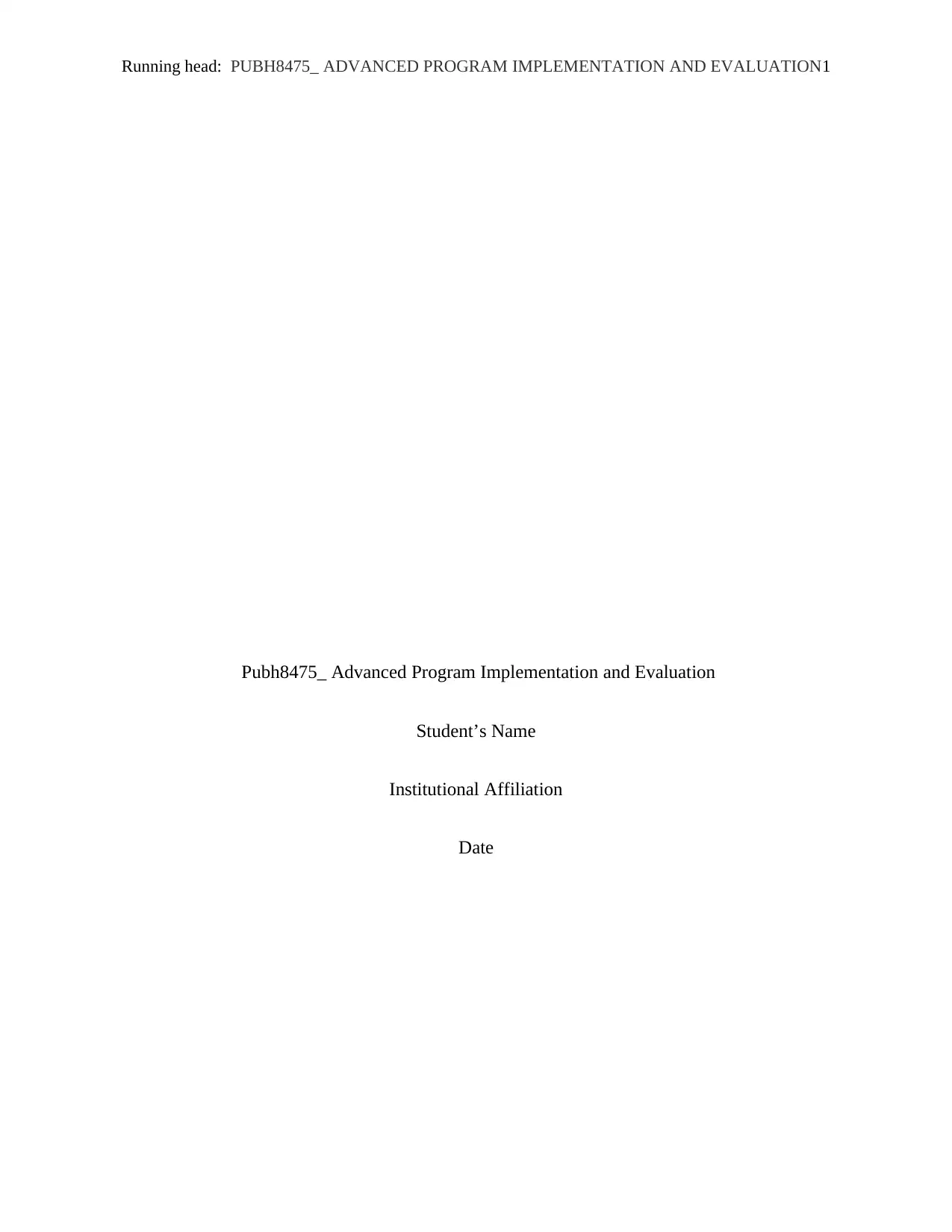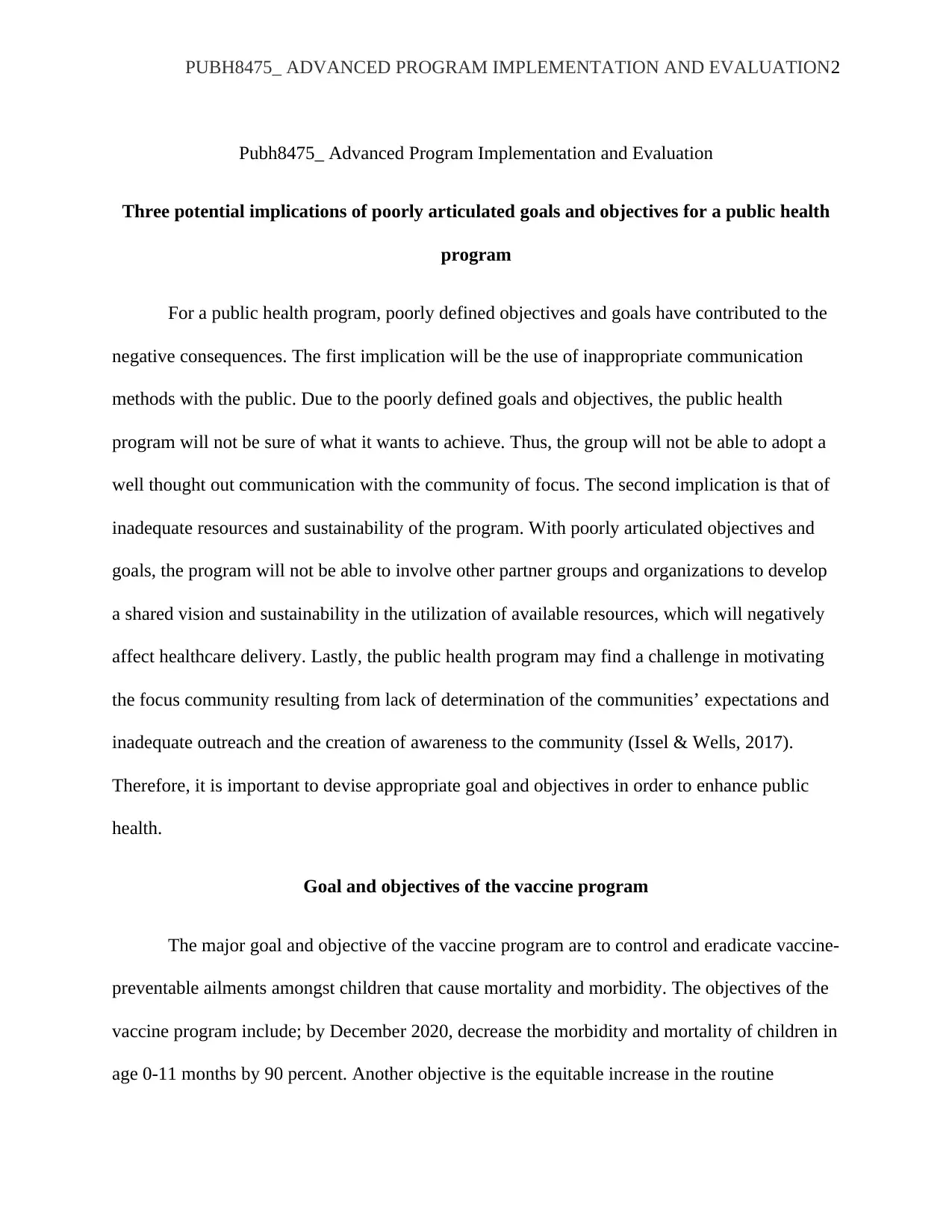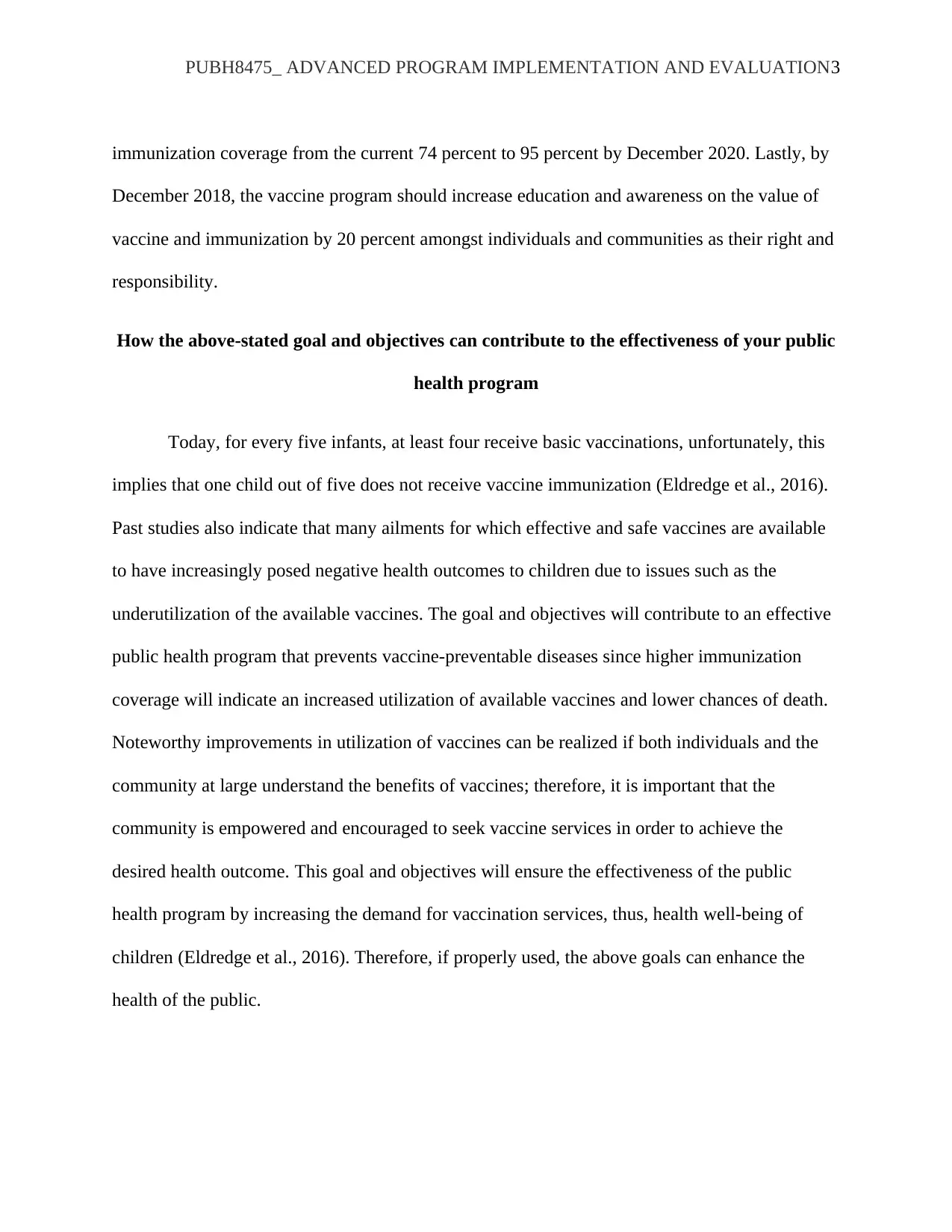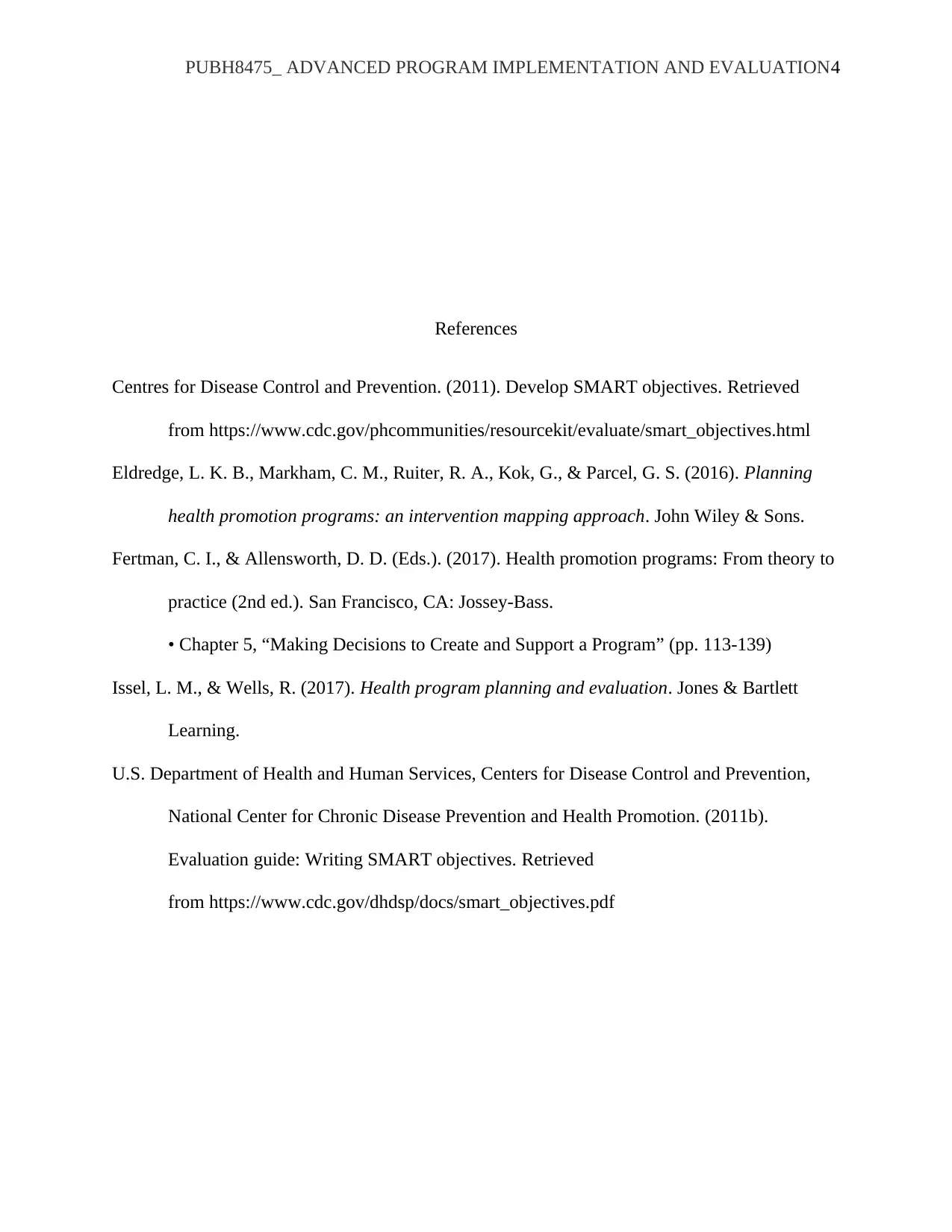PUBH8475: SMART Goals and Objectives for Vaccine Programs
VerifiedAdded on 2023/06/11
|4
|781
|107
Discussion Board Post
AI Summary
This discussion post addresses the significance of clearly defined goals and objectives in public health programs, particularly within the context of a vaccine initiative. It highlights three potential negative implications of poorly articulated goals, including inappropriate communication strategies, inadeq...

Running head: PUBH8475_ ADVANCED PROGRAM IMPLEMENTATION AND EVALUATION1
Pubh8475_ Advanced Program Implementation and Evaluation
Student’s Name
Institutional Affiliation
Date
Pubh8475_ Advanced Program Implementation and Evaluation
Student’s Name
Institutional Affiliation
Date
Paraphrase This Document
Need a fresh take? Get an instant paraphrase of this document with our AI Paraphraser

PUBH8475_ ADVANCED PROGRAM IMPLEMENTATION AND EVALUATION2
Pubh8475_ Advanced Program Implementation and Evaluation
Three potential implications of poorly articulated goals and objectives for a public health
program
For a public health program, poorly defined objectives and goals have contributed to the
negative consequences. The first implication will be the use of inappropriate communication
methods with the public. Due to the poorly defined goals and objectives, the public health
program will not be sure of what it wants to achieve. Thus, the group will not be able to adopt a
well thought out communication with the community of focus. The second implication is that of
inadequate resources and sustainability of the program. With poorly articulated objectives and
goals, the program will not be able to involve other partner groups and organizations to develop
a shared vision and sustainability in the utilization of available resources, which will negatively
affect healthcare delivery. Lastly, the public health program may find a challenge in motivating
the focus community resulting from lack of determination of the communities’ expectations and
inadequate outreach and the creation of awareness to the community (Issel & Wells, 2017).
Therefore, it is important to devise appropriate goal and objectives in order to enhance public
health.
Goal and objectives of the vaccine program
The major goal and objective of the vaccine program are to control and eradicate vaccine-
preventable ailments amongst children that cause mortality and morbidity. The objectives of the
vaccine program include; by December 2020, decrease the morbidity and mortality of children in
age 0-11 months by 90 percent. Another objective is the equitable increase in the routine
Pubh8475_ Advanced Program Implementation and Evaluation
Three potential implications of poorly articulated goals and objectives for a public health
program
For a public health program, poorly defined objectives and goals have contributed to the
negative consequences. The first implication will be the use of inappropriate communication
methods with the public. Due to the poorly defined goals and objectives, the public health
program will not be sure of what it wants to achieve. Thus, the group will not be able to adopt a
well thought out communication with the community of focus. The second implication is that of
inadequate resources and sustainability of the program. With poorly articulated objectives and
goals, the program will not be able to involve other partner groups and organizations to develop
a shared vision and sustainability in the utilization of available resources, which will negatively
affect healthcare delivery. Lastly, the public health program may find a challenge in motivating
the focus community resulting from lack of determination of the communities’ expectations and
inadequate outreach and the creation of awareness to the community (Issel & Wells, 2017).
Therefore, it is important to devise appropriate goal and objectives in order to enhance public
health.
Goal and objectives of the vaccine program
The major goal and objective of the vaccine program are to control and eradicate vaccine-
preventable ailments amongst children that cause mortality and morbidity. The objectives of the
vaccine program include; by December 2020, decrease the morbidity and mortality of children in
age 0-11 months by 90 percent. Another objective is the equitable increase in the routine

PUBH8475_ ADVANCED PROGRAM IMPLEMENTATION AND EVALUATION3
immunization coverage from the current 74 percent to 95 percent by December 2020. Lastly, by
December 2018, the vaccine program should increase education and awareness on the value of
vaccine and immunization by 20 percent amongst individuals and communities as their right and
responsibility.
How the above-stated goal and objectives can contribute to the effectiveness of your public
health program
Today, for every five infants, at least four receive basic vaccinations, unfortunately, this
implies that one child out of five does not receive vaccine immunization (Eldredge et al., 2016).
Past studies also indicate that many ailments for which effective and safe vaccines are available
to have increasingly posed negative health outcomes to children due to issues such as the
underutilization of the available vaccines. The goal and objectives will contribute to an effective
public health program that prevents vaccine-preventable diseases since higher immunization
coverage will indicate an increased utilization of available vaccines and lower chances of death.
Noteworthy improvements in utilization of vaccines can be realized if both individuals and the
community at large understand the benefits of vaccines; therefore, it is important that the
community is empowered and encouraged to seek vaccine services in order to achieve the
desired health outcome. This goal and objectives will ensure the effectiveness of the public
health program by increasing the demand for vaccination services, thus, health well-being of
children (Eldredge et al., 2016). Therefore, if properly used, the above goals can enhance the
health of the public.
immunization coverage from the current 74 percent to 95 percent by December 2020. Lastly, by
December 2018, the vaccine program should increase education and awareness on the value of
vaccine and immunization by 20 percent amongst individuals and communities as their right and
responsibility.
How the above-stated goal and objectives can contribute to the effectiveness of your public
health program
Today, for every five infants, at least four receive basic vaccinations, unfortunately, this
implies that one child out of five does not receive vaccine immunization (Eldredge et al., 2016).
Past studies also indicate that many ailments for which effective and safe vaccines are available
to have increasingly posed negative health outcomes to children due to issues such as the
underutilization of the available vaccines. The goal and objectives will contribute to an effective
public health program that prevents vaccine-preventable diseases since higher immunization
coverage will indicate an increased utilization of available vaccines and lower chances of death.
Noteworthy improvements in utilization of vaccines can be realized if both individuals and the
community at large understand the benefits of vaccines; therefore, it is important that the
community is empowered and encouraged to seek vaccine services in order to achieve the
desired health outcome. This goal and objectives will ensure the effectiveness of the public
health program by increasing the demand for vaccination services, thus, health well-being of
children (Eldredge et al., 2016). Therefore, if properly used, the above goals can enhance the
health of the public.
⊘ This is a preview!⊘
Do you want full access?
Subscribe today to unlock all pages.

Trusted by 1+ million students worldwide

PUBH8475_ ADVANCED PROGRAM IMPLEMENTATION AND EVALUATION4
References
Centres for Disease Control and Prevention. (2011). Develop SMART objectives. Retrieved
from https://www.cdc.gov/phcommunities/resourcekit/evaluate/smart_objectives.html
Eldredge, L. K. B., Markham, C. M., Ruiter, R. A., Kok, G., & Parcel, G. S. (2016). Planning
health promotion programs: an intervention mapping approach. John Wiley & Sons.
Fertman, C. I., & Allensworth, D. D. (Eds.). (2017). Health promotion programs: From theory to
practice (2nd ed.). San Francisco, CA: Jossey-Bass.
• Chapter 5, “Making Decisions to Create and Support a Program” (pp. 113-139)
Issel, L. M., & Wells, R. (2017). Health program planning and evaluation. Jones & Bartlett
Learning.
U.S. Department of Health and Human Services, Centers for Disease Control and Prevention,
National Center for Chronic Disease Prevention and Health Promotion. (2011b).
Evaluation guide: Writing SMART objectives. Retrieved
from https://www.cdc.gov/dhdsp/docs/smart_objectives.pdf
References
Centres for Disease Control and Prevention. (2011). Develop SMART objectives. Retrieved
from https://www.cdc.gov/phcommunities/resourcekit/evaluate/smart_objectives.html
Eldredge, L. K. B., Markham, C. M., Ruiter, R. A., Kok, G., & Parcel, G. S. (2016). Planning
health promotion programs: an intervention mapping approach. John Wiley & Sons.
Fertman, C. I., & Allensworth, D. D. (Eds.). (2017). Health promotion programs: From theory to
practice (2nd ed.). San Francisco, CA: Jossey-Bass.
• Chapter 5, “Making Decisions to Create and Support a Program” (pp. 113-139)
Issel, L. M., & Wells, R. (2017). Health program planning and evaluation. Jones & Bartlett
Learning.
U.S. Department of Health and Human Services, Centers for Disease Control and Prevention,
National Center for Chronic Disease Prevention and Health Promotion. (2011b).
Evaluation guide: Writing SMART objectives. Retrieved
from https://www.cdc.gov/dhdsp/docs/smart_objectives.pdf
1 out of 4
Related Documents
Your All-in-One AI-Powered Toolkit for Academic Success.
+13062052269
info@desklib.com
Available 24*7 on WhatsApp / Email
![[object Object]](/_next/static/media/star-bottom.7253800d.svg)
Unlock your academic potential
© 2024 | Zucol Services PVT LTD | All rights reserved.




